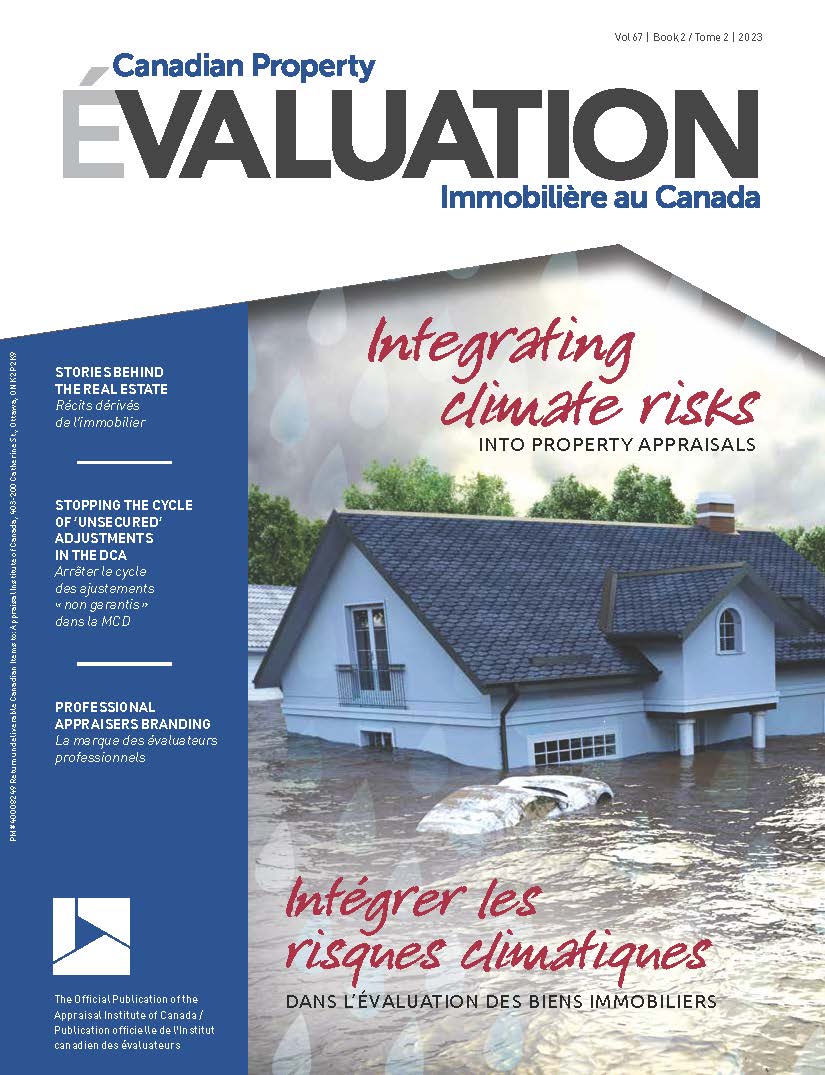Integrating climate risks into property appraisals helps protect Canada’s real estate market
Canadian Property Valuation Magazine
Search the Library Online
Climate change-influenced extreme weather events, such as floods, ice storms and wildfires, pose a growing physical threat to properties across Canada. Recent studies have shown that they can also have a material and long-lasting impact on property values. By accessing publicly available risk maps, local media coverage, inspecting a subject property for evidence of past damage, and identifying comparables with similar risk profiles, Members of the Appraisal Institute of Canada (AIC) can make data-informed adjustments to property valuations, where applicable.
The growing threat to Canadian real estate
These climate-influenced extreme weather events also pose a growing threat to the entire Canadian real estate industry. The nation-wide financial impacts of climate-influenced catastrophic insurable losses have been tracked by the insurance industry since the early 1980s. Over the last decade, Canada has experienced a five-fold increase in the annual insurable losses due to catastrophic extreme weather events. Average annual catastrophic insurable losses have surged from $400 million per year from 1980-2008 to just over $2 billion per year since 2009 (Insurance Bureau of Canada (IBC), 2022). The insurance gap, which is defined as the difference between what insurers cover to restore properties following a loss versus what government, business and individuals need to pay to achieve full recovery, is sizeable. For every $1 paid out by insurers, it is estimated that an additional $3-4 is needed to complete repairs (IBC, 2022).
Floods pose financial risks to property owners and lenders
Flood-related events represent greater than 50% of catastrophic insurable losses across the country. A study by the IBC estimated that 1 in 10 Canadian homes is at high risk of flooding from extreme rainfall events, rivers overtopping their banks, or coastal flooding (IBC, 2022). Facing home insurance prices that have jumped an average of 20-25% over the past five years, policy restrictions that limit coverages and payouts from extreme weather events, and an average price tag of $43,000 attached to the restoration of a water-damaged basement, property owners often struggle to rebuild after a loss (Bakos et al., 2022). Coupled with rising interest rates that have increased the financial vulnerability of homeowners, climate-related extreme weather events place lenders in the crosshairs of potential mortgage defaults in high-risk locations. By integrating climate risks into property appraisals, AIC Members can help to ensure that prospective buyers do not overpay for at-risk properties and that lenders do not extend more funds than they can secure if a default occurs.
Material and long-lasting impacts on property values
Climate risks and property value impacts vary widely across Canada. North America-wide research that looked at property value impacts from extreme weather events from 1980-2018 found that actual catastrophic events rather than hazard disclosure on maps can have material impacts (Chopik, 2019). For example, following a large-scale flood in Oregon in 1983, the value of impacted properties dropped between 19-26% compared to non-impacted properties with similar characteristics within the same community. However, homes that appeared to be at high risk of flooding on publicly available maps, but that had not been flooded, did not show an effect on value.
Catastrophic events can also have long-lasting impacts on property values. For example, following the 2013 Calgary, Alberta flood, property values dropped on average between 15-60%. One year later, a 10-25% property value discount compared to non-impacted properties was still noted. The study goes on the say that full price recovery can take from 6 months to 10 years, with an average recovery time of 3-4 years. In locations with chronic issues, such as the North Carolina coast, where property erosion is significant, a 53% price reduction of impacted versus non-impacted properties has become permanently baked into local home prices.
A 2022 Canadian residential flood impact study examined the short-term impacts on the real estate market in six communities that had experienced 1-2 catastrophic floods between 2009 and 2020 (Bakos et. al., 2022). The study compared the sold prices, number of days on the market, and number of homes listed in flooded versus non-flooded neighbourhoods six months before and six months after a flood. Price impacts ranged widely (e.g., from -1.1% in Grand Forks, BC, and -17.1% in Gatineau, Québec) with an average 8.2% lower sold price of flooded versus non-flooded comparables. Flood impacted properties also took an average of 19.8% longer to sell and 44.3% fewer homes were listed in flooded versus non-flooded locations within the same community.
Guidance available to Members
In 2022, in response to the growing threat that flooding poses to Canada’s real estate market, the AIC, the University of Waterloo’s Intact Centre on Climate Adaptation, and the University of British Columbia’s Sauder School of Business, jointly created an AIC Professional Member Bulletin entitled Guidance to AIC Members on Integrating Flood Risks into Property Appraisals.
As per the Canadian Uniform Standards of Professional Appraisal Practice (CUSPAP) (7.5.1.i), property appraisers must inspect the subject property and undertake the appropriate research to identify any potential adverse risks to that property. Increasingly, an adverse risk to subject properties includes flooding. By following the three simple steps outlined in the Member Bulletin and by accessing a variety of user-friendly AIC resources in the A-Z Library under ‘Flood,’ appraisers can make data-informed adjustments to property valuations, where applicable.
Better data, better protection for Canada’s real estate market
At this point in time, publicly accessible, easy to understand climate risk maps are not widely available across Canada. Limits to consistent and reliable data present barriers to the integration of climate risks into property appraisals in Canada. Fortunately, a critical first step to accessing better climate risk data is on the horizon. In its March 2023 budget, the federal government made a $15 million funding commitment to prioritize the completion of a national, searchable, publicly accessible flood risk portal within the next two to three years. As access to climate risk data improves so too will the ability of Members to help protect Canada’s real estate market by integrating climate risks into property appraisals.





